|
We gardeners tend to be creatures of habit. For years I headed out in fall to prepare my garden beds for winter. Pruners in hand, I attacked almost all my perennials, cutting them nearly to the ground as gardening books at the time said to do. Then along came Tracy DiSabato-Aust, with her book The Well-Tended Perennial Garden - Planting & Pruning Techniques. Her wealth of knowledge jumps at you from every page. This acknowledged "Queen of Pruning" shares her observations, giving us all the benefit of her own experience.
I had no idea just how many plants would benefit from being left alone in fall and tidied up only after they put in their appearance when winter was over. In this book we learn not only when or when not to prune individual perennial species and cultivars but also why or why not.
The author reminds us that some foliage left unpruned in fall may provide winter shelter to some bird species. In addition she explains that ornamental value and winter interest can come, not only from the conifers and shrubs that are always left standing, but also from perennial seedheads (many provide food for different bird species), stem colour, evergreen foliage and even the basic structure and form of the perennials left upright in a garden over the winter months.
* Watch for the animated hummingbird and butterfly with the plants that attract them. *
The deer icon indicates plants that deer are not usually attracted to.
   The best time and method to propagate plants can be found on our image-intensive PROPAGATION page.
To help your plants grow their best, check out our FERTILIZATION page.
To create your own plant partnerships based on tried and true color theory, check out our GARDEN COLOR page.
To see if a particular plant is on this page press Ctrl+F, type in the name, then click the Find button.
The best time and method to propagate plants can be found on our image-intensive PROPAGATION page.
To help your plants grow their best, check out our FERTILIZATION page.
To create your own plant partnerships based on tried and true color theory, check out our GARDEN COLOR page.
To see if a particular plant is on this page press Ctrl+F, type in the name, then click the Find button.
NO FALL PRUNING RECOMMENDED & WHY
Break your old habits and leave the following plants unpruned or pruned back only to basal foliage for the winter. After all, who wouldn't follow advice that reduces the fall work load in the garden, provides winter interest and shelters and feeds many different birds! If you're afraid you'll cut back plants that should be left alone just do as I do. Insert short garden stakes in front of these clumps to avoid pruning them back accidentally. Once everything else has been done the stakes can be removed and stored away.
Acanthus: Bear's Breeches
- finished bloom spikes may be cut off at the base
- cut off any old foliage that collapses to the outside of the plant by late summer
- leave new basal foliage over winter
- cut off damaged foliage in the spring
Aconitum: Monkshood

- cut back to any new basal foliage after flowering has finished
- leave this basal foliage over winter and cut off in spring
Ajuga: Bugleweed

- plants are evergreen
- do not prune foliage for winter
- may need only dead-leafing in spring
Anaphalis: Pearly Everlasting
- do not prune in fall for the winter
- cut plant back only in the spring
Anthemis: Golden Marguerite
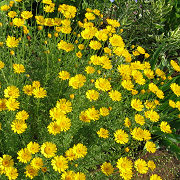
- plants should be cut back to new evergreen basal foliage after flowering by late summer
- leave this basal growth for the winter
- prune off only damaged growth in spring
Arabis: Rockcress
 
- plants should be cut back and shaped immediately after flowering
- do no more pruning prior to winter
- clean up any dead foliage in spring
Armeria: Thrift

- remove deadheads and stalks after bloom to basal foliage
- this plant is evergreen so no fall pruning should be done
- remove winter damage in spring
Artemisia: Artemisia, Mugwort
  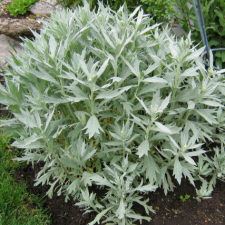
- do not cut back into old woody sections at any time
- plants can be shaped and cut back early in the season
- do no pruning after August
Arum: Arum

- this plant is evergreen so should not be cut down in autumn
- simply dead-leafing in spring will remove untidy foliage
Asarum europaeum: European Wild Ginger
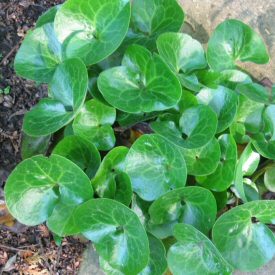
- plant is evergreen to semi-evergreen and requires no fall pruning
Asclepias: Butterfly Weed

- do not cut back in autumn
Astilbe: Astilbe
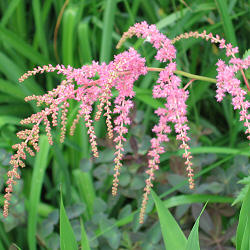
- performs best if not pruned back in fall
Astrantia: Masterwort

- cut stems to basal foliage after flowering is finished
- leave basal foliage intact until spring
Aubrieta: False Rockcress
 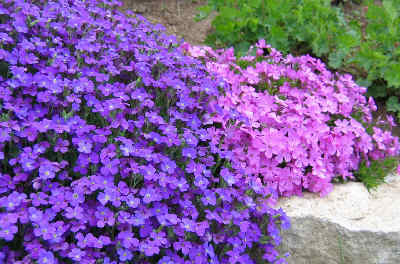
- this plant is evergreen
- pruning may be done at stages during summer
- do no pruning after mid-summer
Aurinia saxatilis: Basket-of-Gold
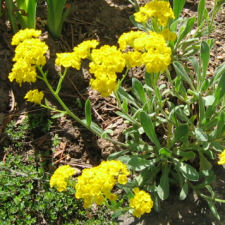
- evergreen or semi-evergreen
- leave intact over winter
Bergenia: Bergenia, Pigsqueak
Buddleia: Butterfly Bush
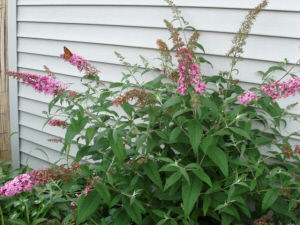
- this is a shrub that should not be cut back until spring
Digitalis: Foxglove

- new basal foliage may appear during summer
- after blooming is finished, cut plants back only to this basal foliage
- dead foliage can be removed in spring
Echinops: Globe Thistle

- cut back to basal foliage after bloom
- if rebloom occurs cut back stems to basal foliage
- leave over winter and tidy up in spring
Epimedium: Barrenwort
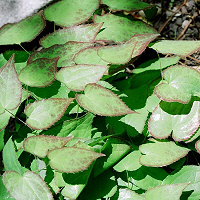
- this plant is semi-evergreen
- leave foliage for winter interest
- cut back unsightly old foliage in very early spring
Eryngium: Sea Holly
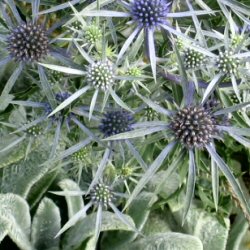
- deadhead back to basal foliage which remains evergreen
- leave for winter and prune in spring
Euphorbia: Spurge
- shear back and shape plants immediately after flowering, to prevent excessive seeding
- clean up foliage in spring
Gaillardia: Blanket Flower
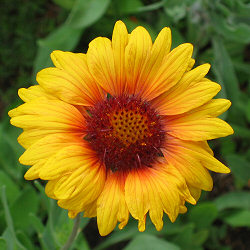
- cut flowering stems to basal foliage in late August-early September
- preventing further blooming helps the plant's survival chances
- any new basal foliage that appears should be left until spring
Geum: Avens, Geum
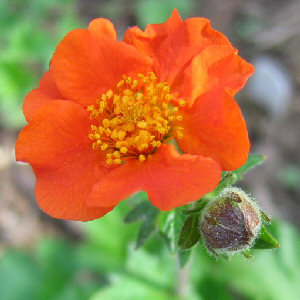
- this plant is semi-evergreen
- cut stems to ground after flowering finishes
- cut foliage back only to new basal growth
- reserve full cut back until spring
Helianthemum: Sun Rose, Rock Rose
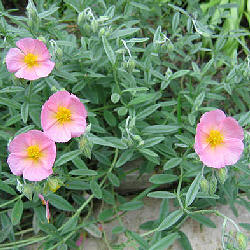
- an evergreen sub-shrub
- do not prune after late August
- plants may need only a very light trim in early spring
Heuchera: Coral Bells
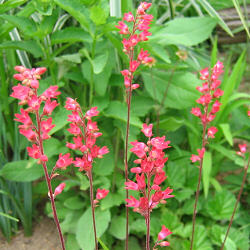
- older top growth can be cut off in late summer
- this may reveal better foliage underneath
- do not prune further for winter
- remove winter-damaged foliage in spring
Hypericum calycinum: St. Johnswort

- plants are evergreen to semi-evergreen (depending on climate)
- shear in early spring to remove winter damage
Iberis: Evergreen Candytuft

- this plant's foliage is evergreen
- cut back only immediately after flowering
- any winter damage can be removed in spring
Kniphofia: Red-Hot Poker

- cut old flower spikes to the ground after bloom
- cut foliage back at the same time by no more than half
- in fall tie foliage over the top of the clump for winter protection
Lamium: Dead Nettle
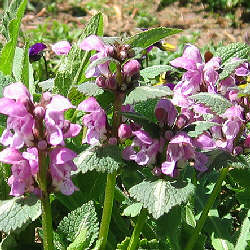
- cut back to basal foliage in mid-summer
- winter damage should be minimal
Lavandula: Lavender
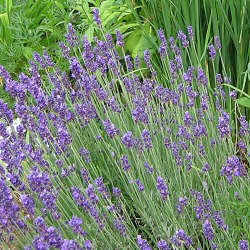
- remove old flowering stems after bloom
- do not prune after late August
- remove tips that sustain winter damage after new growth has appeared in spring
Limonium: Sea Lavender
- foliage is evergreen to semi-evergreen
- do not prune for winter
Liriope: Creeping Lilyturf
- foliage remains evergreen into early winter
- shear to ground in spring to encourage new growth
Lupinus: Lupine
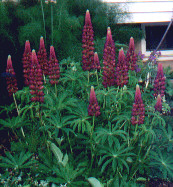
- cut back to new basal foliage in July
- do no further cutting back until spring
Lychnis:
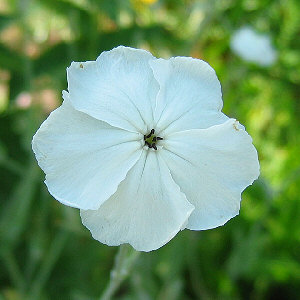
- this plant is a biennial
- cut stems to basal foliage after bloom
- silvery-grey foliage stays nice into winter
- cut off winter-damaged foliage in spring
Nepeta x faassenii: Catmint
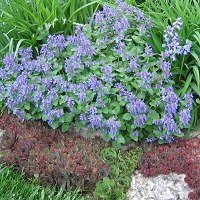
- prune only immediately after flowering
- you may cut back after several killing frosts or leave foliage until spring
All of our own Gardens By The Bay pages can be accessed by clicking on the links below.
HOME
GARDEN POETRY |
GARDEN POETRY MUSE
GEORGIAN BAY VIEW
BOTANICAL LATIN - BASICS
COLOR THEORY
THE GARDENS
CORNER GARDEN CONSTRUCTION |
CORNER GARDEN PLANTING |
LONG GARDEN
EAST GARDEN |
HOSTA GARDEN |
NORTH GARDEN |
WINTER GARDENS
PLANT PARTNERSHIPS
BLUE PERENNIALS Aconitum -
Geranium |
Iris - Vinca
BULBS Allium - Hyacinthus |
Narcissus only |
Tulipa only |
Minor Bulbs
BUTTERFLY MAGNETS Anaphalis - Hemerocallis |
Liatris - Veronicastrum
 DAYLILIES Spider & Unusual Form DAYLILIES Spider & Unusual Form EDGERS Arabis - Iris |
Nepeta - Veronica
FOLIAGE PERENNIALS
Alchemilla - Tanacetum
HOSTA Hosta - all
HUMMINGBIRD-FRIENDLY PERENNIALS Alcea - Salvia
ORANGE PERENNIALS Achillea - Tulipa
ORNAMENTAL GRASSES Acorus - Imperata |
Miscanthus - Spodiopogon
PINK PERENNIALS Achillea - Lilium |
Lychnis - Veronica
PURPLE PERENNIALS Aconitum - Liatris |
Polemonium - Veronica
RED PERENNIALS Achillea - Veronica
SHADE PERENNIALS Aegopodium - Erythronium |
Ferns - Polemonium |
Polygonatum - Vinca
SILVER FOLIAGE PERENNIALS
Achillea - Cerastium
|
Cornus - Limonium
|
Lunaria - Veronica
SIMPLY SPECIAL PERENNIALS Acanthus - Saxifraga
WHITE PERENNIALS Achillea - Iris |
Kalimeris - Yucca
YELLOW PERENNIALS Achillea - Hypericum |
Inula - Verbascum
VARIEGATED-FOLIAGE PERENNIALS Acorus - Erythronium |
Hakonechloa - Lysimachia |
Miscanthus - Yucca
PLANT PROFILES
Dianthus 'Tiny Rubies' |
Geranium |
Geum coccineum |
Kerria japonica |
Knautia macedonica
Paeonia tenuifolia |
Papaver somniferum |
Rudbeckia |
Salvia 'East Friesland'
Trollius |
Veronica 'Sunny Border Blue'
PROPAGATION
DIVISION - SPRING ONLY |
DIVISION - FALL ONLY |
DIVISION - SPRING OR FALL |
DO NOT DIVIDE
FERTILIZATION
EDGERS Arabis - Iris |
Nepeta - Veronica
FOLIAGE PERENNIALS
Alchemilla - Tanacetum
HOSTA Hosta - all
HUMMINGBIRD-FRIENDLY PERENNIALS Alcea - Salvia
ORANGE PERENNIALS Achillea - Tulipa
ORNAMENTAL GRASSES Acorus - Imperata |
Miscanthus - Spodiopogon
PINK PERENNIALS Achillea - Lilium |
Lychnis - Veronica
PURPLE PERENNIALS Aconitum - Liatris |
Polemonium - Veronica
RED PERENNIALS Achillea - Veronica
SHADE PERENNIALS Aegopodium - Erythronium |
Ferns - Polemonium |
Polygonatum - Vinca
SILVER FOLIAGE PERENNIALS
Achillea - Cerastium
|
Cornus - Limonium
|
Lunaria - Veronica
SIMPLY SPECIAL PERENNIALS Acanthus - Saxifraga
WHITE PERENNIALS Achillea - Iris |
Kalimeris - Yucca
YELLOW PERENNIALS Achillea - Hypericum |
Inula - Verbascum
VARIEGATED-FOLIAGE PERENNIALS Acorus - Erythronium |
Hakonechloa - Lysimachia |
Miscanthus - Yucca
PLANT PROFILES
Dianthus 'Tiny Rubies' |
Geranium |
Geum coccineum |
Kerria japonica |
Knautia macedonica
Paeonia tenuifolia |
Papaver somniferum |
Rudbeckia |
Salvia 'East Friesland'
Trollius |
Veronica 'Sunny Border Blue'
PROPAGATION
DIVISION - SPRING ONLY |
DIVISION - FALL ONLY |
DIVISION - SPRING OR FALL |
DO NOT DIVIDE
FERTILIZATION
BULBS |
ORNAMENTAL GRASSES |
PERENNIALS |
SHRUBS |
VINES
PRUNING
NO FALL PRUNING
LINKS
GARDENS |
LOCAL GARDENS |
BOTANICAL TERMINOLOGY
GARDENING BOOKS |
NON-GARDENING
HOME
|